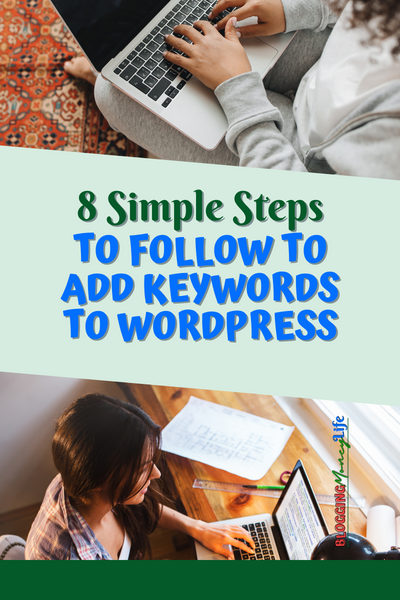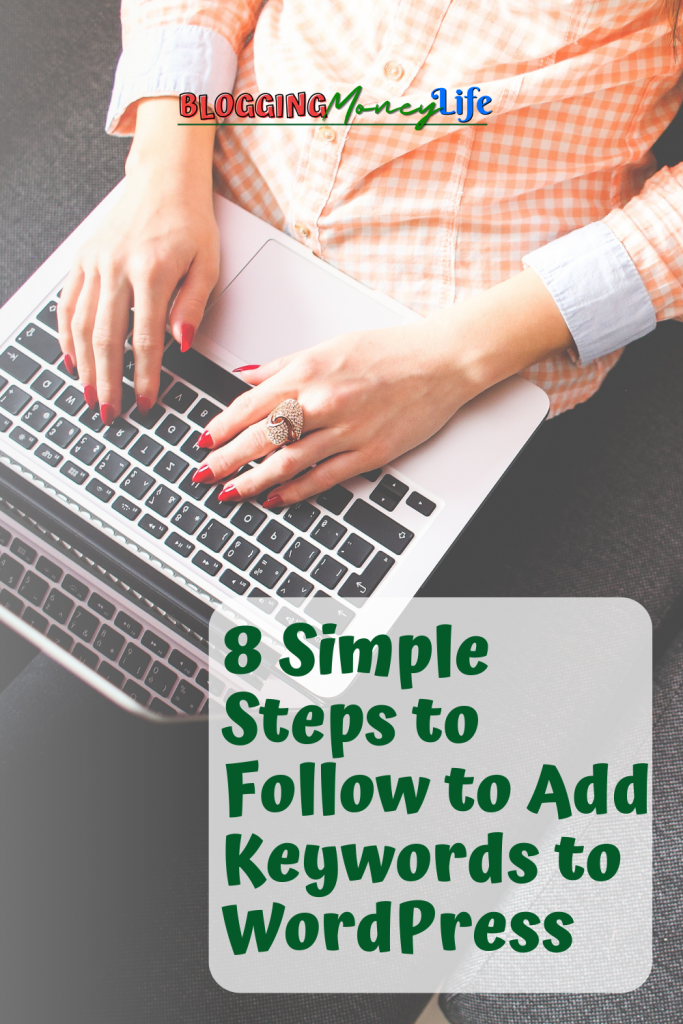8 Simple Steps to Follow to Add Keywords to WordPress

Need to know how to add keywords to WordPress? Then, you’ve come to the right place.
WordPress is the most popular platform to build websites on, and with millions of installations, it’s one of the easiest ways to start your website. Although, it can also seem like an overwhelming tool if you don’t know how to use it effectively, even though it’s pretty simple.
However, just because it’s simple to use doesn’t mean you can get away without learning to improve your site’s visibility with search engine optimization (SEO). SEO is essential to your website’s overall marketing strategy, whether you’re just starting or blogging for years.
The best way to do this is by adding keywords throughout your WordPress site to ensure visitors can easily find your content online via search engines such as Google and Bing. Keywords are an integral part of any effective SEO strategy, but it can be hard to find the time or know where to start if you’re new to WordPress.
Here are eight steps you should follow to create an effective keyword strategy in WordPress with minimal fuss and maximum effectiveness and search appearance so that you appear at the top of your search query.
Step #1: Research Why Having a Focus Keyword (& Meta Keywords) Are Important
A focus keyword is important because it tells people about your blog post. The more specific your focus keyword, the better your chance of ranking higher on search engines like Google and Bing.

The meta keywords are also essential because they give search engines a preview of what you’re trying to get across. Meta keywords list 2-3 words or phrases describing your page content.
If possible, these words should be the same as your site’s focus keyphrase (usually found in the functions.php file). When targeting a long-tail keyword, these words can be just one word or two – but usually, three is best.
You can also use keywords from other blog posts by including them in the page title and meta tags. The best practice when using keywords is to have them in the URL and HTML code on every website page as often as possible.
You can use WordPress plugins for keywords to help you find relevant and popular keywords. It’s best to have at least five focus keywords per post, and they should be included within your content.
You may even want to write posts that contain a sentence using one of your main focus keywords and then have another sentence with one of the secondary focus keyphrases but only do this if it makes sense.
The best practice is optimizing each page and post by adding your focus or target keyword to the title tag, meta title, description, and header tags. In addition, make sure your functions.php file contains text using the same keyword.
If you are looking for the easiest way to improve your site’s rankings, look no further than adding a specific keyword relevant to your posts’ content and choosing a good focus keyphrase. Your page SEO ranking will improve significantly if you follow these simple steps.
Step #2: Do the Keyword Research
The first thing is to do keyword research, which will help you identify the specific keywords your blog should focus on. Plus, it will give you a way to measure the success of your chosen keywords.
Check out Jasmine’s excellent video on how to do this!
Several tools can help with this process, such as Google Keyword Research Tool, Google Trends, Wordtracker, or Ahref (There are so many online, you can research for one that you would like).
You can also run keyword research on these tools to be sure your chosen keyword would rank. There’s nothing as good a result as being sure your keywords will rank and getting surety from a different platform.
Some great WordPress SEO plugins for keyword research are available, like All-in-One SEO Pack Yoast’s WordPress SEO plugin. Or SEMRush Once you have found an excellent list of relevant keywords, start adding them to the titles and content of your posts.
Make sure to target one main keyword per post so that all content leads back to that topic. It is also important to incorporate keywords throughout the page content rather than just the title or heading.
When creating page content, a good rule of thumb is ensuring every word includes at least one target keyword. Remember to be creative with using keywords by including synonyms and phrases in addition to single terms.
Synonyms offer more opportunities for search engine optimization because they broaden your search query without repeating yourself too much. For example, instead of using the best SEO company, try using SEO company rankings.
Incorporate Keywords Throughout – page ranking matters! Pages with high page ranks get preferential treatment from the major search engines. As a result, these pages tend to appear higher in the search engine results pages (SERPs).
Pages with low page rank may not show up at all. If you want your page to class, include keywords throughout the page content and ensure that it contains appropriate tags.
Step #3: Use the Yoast SEO Plugin
Yoast SEO Plugin for WordPress Website is a must-have tool for bloggers and webmasters. The plugin helps you optimize your page title, meta name, and more.

The best part about this plugin is that it gives you tips on ranking higher with your keywords. The Yoast SEO section also has a search appearance option where you can change the color of your font to contrast against other fonts used on the page.
This plugin includes many features, such as tracking rankings, a readability meter, schema markup support, and an XML sitemap. Many features and work will go into creating content people will enjoy reading.
To succeed online, this WordPress Plugin is necessary to ensure your content is optimized for SEO ranking. Whenever you create new pages for your website, Yoast SEO Plugin for the WordPress Website makes adding keywords related to the page’s topic easy.
Additionally, Yoast SEO Plugin provides suggestions on what to do if you’ve got pages that need improvement regarding keyword usage. If you feel Yoast is beyond your knowledge and expertise as a wordpress owner, we recommend you seek the expertise of one or more SEO experts who can help design a wordpress site that ranks well in google searches.
Step #4: Double-Check With SEMRush
Whether a blogger or an entrepreneur, it’s essential to have your site ranked as high as possible. As we said earlier, one way to do that – is that many people need to correct things.
You can’t just add words randomly. Instead, you’ll need to use a keyword tool like SEMRush to find the best ones for your industry and then add them strategically throughout your post and around relevant keywords on your website.
If you want to be specific, check out their blog post about page SEO. In addition to adding the right keywords, you also want to be sure they are placed in the right areas and indexed correctly. That’s why using a keyword placement tool like SEMRush is essential.
It will tell you exactly where you should place your keywords based on what other sites are doing to rank higher. The last thing you want to do is create a well-written piece with great content only to ruin everything because the wrong keyword was used.
Use SEMRush to track which keywords are working and which aren’t and focus on those instead. Remember, only some keywords will work for your niche, so save time trying to incorporate something if it doesn’t seem elsewhere.
Finally, remember mobile optimization. Mobile internet usage has surpassed desktop usage, so optimizing your site for mobile devices is critical. SEMRush has resources to help you do this. Check out one of their blogs on optimizing your mobile website.
Not sure if SEMRush is for you? Check out my review I did on SEMRush below.
Step #5: Choose the Best SEO Title
Choosing the best SEO title is key to ranking high in search engine results pages. The title should be relevant and include keywords that people are searching for. This will help your website stand out from the competition and drive more traffic your way. But choosing an SEO-friendly title is more complex than it sounds.

Here are eight steps you must follow when deciding on a good SEO title
- Include keywords
- Be accurate
- Don’t use any spaces or special characters
- Make it descriptive but concise
- Avoid stuffing words into the title unnecessarily
- Think about how readers would respond to your title
- Use capital letters sparingly
- Double-check everything before publishing.
It can take time to perfect your SEO strategy, so wait to publish anything until you’re sure it’s perfect. Instead, keep these tips in mind while developing your SEO strategy; you’ll find better rankings in no time.
Remember that this is just one step of many; once you have an optimized title, you’ll want to optimize your tags and keywords. For example, your page title should not repeat the same keyword once, which could look spammy to Google.
You can also think about what someone who knows nothing about your blog might say if they see your title. For example, instead of What You Should Know About SEO, try A Beginner’s Guide to SEO.
Step #6: Fill Out the Meta Description
The Meta Description Field is the sentence or two that appears when you click on a post from your homepage. It helps search engines and visitors know what your post is about, so spending time crafting the perfect description is essential.
Suppose your installed wordpress theme doesn’t come with a blog meta description; consider using the Google AdWords keyword planner to find out which keywords will most likely bring you traffic.
Also, include the focus keyword at least once in your meta title and subtitle. The key to a compelling meta description is brevity. Don’t let this field from taking up a maximum of a few sentences.
Try writing less if you feel like there’s more to say. For example, a concise description makes it easier for readers to decide whether they want to read your content. On the other hand, what seems like a clever detail could dissuade someone from reading your post by making it seem too complicated or long-winded.
The best way to craft a killer meta description is to provide enough information to encourage people to continue reading while avoiding mentioning negative topics. In some cases, authors might choose not to include the keyword in their meta description because it feels forced.
Step #7: Make Sure the Keyword Density Is Balanced
Make sure that the keyword density is balanced. You want your content to be readable and engaging, not filled with keywords. On the other hand, when a post or page has too many keywords, it may start to sound spammy and annoying.

The best way to determine if you have an appropriate keyword density is by using Google’s Adwords tool. Plug in a sentence and see what the suggested search term is.
If the results come back as good, then you should keep writing with this frequency of keywords. On the other hand, if the results come back as spammy, then make adjustments accordingly.
For example, some pages or posts are informational and will naturally contain more keywords than others. But on the other hand, sticks, where you introduce new products, need fewer keywords because they are focused on providing information about one product at a time.
Step #8: Don’t Forget the Image Alt Text
When you upload an image, be sure to include the alt text. The alt text describes the image and should be about 200 characters or less. It’s not only important because it helps with search engine optimization but also so that visually impaired readers can understand what’s happening in the image on your site.
Be sure to use keywords when writing your alt text. That means having keywords in the first 100 words of your alt text, keeping the content short (150 words max), adding numbers, etc.
And remember to change the alt texts now and then by changing the keyword or two each time. You’ll have the best chance of ranking well in Google if your alt text is written according to how Google interprets images.
Wrapping Up
In conclusion, these 8 steps are a great start to optimizing your site’s content and keywords. The more you know how search engines work, the better off you’ll be.
Take the time to research other sites’ keyword strategies, research what keywords might make sense for your niche, and find out what terms people use when searching online. Always keep an eye on your analytics to see which of your posts have been shared the most so you can go back and optimize them if needed.



